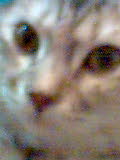 |
 |

CAT'S
MIND-Communication Many And they've got a lot to talk with -- if our eyes took were as big on or heads as cats' eyes are in theirs, our eyes would be eight inches long, each. Cats' eyes also bulge out slightly, giving them excellent peripheral vision. You may have noticed that, while you stumble around in the dark looking for the light switch, your cat is calmly picking her way around the furniture. You may have also noticed that sometimes in a dim room, your cat's eyes will glow eerily. This isn't because she's suddenly been possessed by Aunt Matilda's ghost. Rather, as nocturnal predators, cats have developed excellent night vision. Cats have vertical irises, which can narrow to the tiniest sliver in bright light or open to cover 90 percent of their eye area, enabling the pupil to capture even the smallest amount of light. In addition, they have a shiny membrane in the back of their eyes called the tapetum lucidum, which helps reflect light back through the retina, enabling the cat to see better in low light. However, they still can't see in total darkness. As anyone knows who has watched a bug try to get across the floor and not get pounced on by the cat, cats are acutely attuned to movement. In our own eyes, rods react to intensities of light, while cones react to color. A cat's eyes have more rods and fewer cones in their eyes than we do. This means that while we have better color vision, a cat can detect motion better. But all that sensitivity to motion comes at a price: Cats don't actually see close objects very well. After all, what's the advantage of seeing the mouse once it's in your paws? Cats also have a third eyelid to protect their eyes as they stalk prey through grass and underbrush. Called the nictitating membrane, this eyelid rests at the inside corner of the eye. If a cat's eyes are inflamed or irritated, you may see this membrane start to protrude. If a cat is seriously ill or debilitated, the membrane will partially cover the eye (and that's a definite signal to take your cat to your veterinarian). While it's not completely certain how much and which colors a cat can see, there's no doubt that the colors that cats' eyes come in -- copper, gold, green, orange, yellow, blue, and lavender -- are beautiful. Many cat owners say they chose their cat because of his or her eyes. Given the power of a cat's eye, perhaps they were mesmerized.
|
![]()
Please don't forget to leave your paws in the
Purrfect guestbook!!!
![]()
![]()
Top Of Page
| Back
| About Us | Home
| Choosing A Cat | Behaviour
| Care | Health
| Breeds | Facts
| Humour | Poems Glossary
| My Cat Pictures
| Books | Links |
Bookmark | Contact
Us | Terms Of Use | Disclaimer
| Privacy Policy
Copyright © 2006 ThePurrfectPaws
All Rights Reserved.
Feline Illustrations by Abida
Fahim
 cat lovers suspect that cats communicate with their eyes and some
shelter workers even swear by the slow eye blink as a way to calm
feral cats down. Cats also use their eyes to intimidate prey and
even each other, as a way of establishing dominance.
cat lovers suspect that cats communicate with their eyes and some
shelter workers even swear by the slow eye blink as a way to calm
feral cats down. Cats also use their eyes to intimidate prey and
even each other, as a way of establishing dominance. 